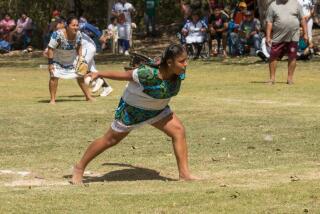Choctaw stickball: A fierce, ancient game deep in Mississippi
- Share via
Reporting from Choctaw, Miss. — Bum, bum, bum, bum …
As the Choctaw drummer settles into his cadence, nearly 100 men in blood-red shirts, shorts and bandannas huddle around their leader in a darkening high school parking lot beneath the golden glow of a floodlight.
“Big night!” James Denson, the team’s star player, shouts three times. At 6-foot-3, he’s taller than most, a muscular 208 pounds and square-jaw handsome. His team, Beaver Dam, is just minutes away from playing in the championship game of an ancient and violent sport known as stickball, a cousin of lacrosse that is defiantly true to its American Indian roots.
“Do y’all want it bad?” Denson asks.
They answer, bouncing foot to foot on the warm asphalt, banging together pairs of hickory sticks outfitted with oblong netted loops at the ends.
The 200 or so sticks slamming together create a high-pitched clatter like simultaneous pistol fire that echoes off the asphalt and syncs up with the drum being pounded about 60 beats per minute. That’s the tempo of a healthy, beating heart at rest. And that is what the drumming represents — the game’s heartbeat.
The players begin shouting and whooping, loud and louder, drowning out the crickets chirping in the nearby skyscraper pine trees.
“Then let’s go get it!” Denson shouts, and they crash down a tunnel toward the football field, bashing their sticks on concrete walls, on metal poles, screaming mad, wild-eyed.
For centuries, tribes played to settle their disputes without weapons, hence stickball’s nickname, “Little Brother of War.” But the game still was brutal. In the late 1800s, James Mooney, an American anthropologist, declared: “Almost everything short of murder is allowable.”
It’s still known for violence. Players wear no pads, no helmets and rarely shoes. Most veterans have multiple scars, often cutting through eyebrows because the nearly 32-inch sticks, usually carved from concrete-hard hickory, tend to smack there.
The nine-day Choctaw World Series of Stickball tournament this summer featured 45 teams, most from central Mississippi, the tribe’s ancestral home. But on this night, only Beaver Dam and Conehatta, two bitter rivals, remain. Beaver Dam is trying for its fourth straight championship.
Before 5,000 fans, the teams march single file onto the field, Denson in the middle of Beaver Dam’s pack and the drummer out front, always out front.
Bum, bum, bum, bum …
Denson was 9 when his father took him to watch a stickball practice. Now 31, he’s arguably the best player in Mississippi and one of the most recognizable figures at the tribe’s fair held each summer near the town of Philadelphia.
As he walks the fairgrounds, friends and fans call out: JD! James D!
He smiles and replies in Choctaw. Few can speak it back. Time, assimilation and efforts by the government to “civilize” American Indians have contributed to its decline.
But stickball holds on. For many it is more than a game.
“It’s probably the only thing we’ve kept as a cultural property,” says Olin Williams, 59, who grew up in Mississippi, played the game and works at an Oklahoma Indian museum.
Though the championship game will be broadcast on local television, the sport isn’t covered by mainstream media. Henry Williams, the series’ commissioner, likes it that way. Should there be national attention, he says, “they’ll take it away from us.”
In tolih, as the game is known in Choctaw, two 12-foot-high wooden posts 4 inches wide stand at opposite ends of the field. Points are earned when players, using their sticks, or kobocca, hit the opposing post with the towa, an egg-sized ball wrapped in woven strips of deer hide or leather.
Thirteen orange-shirted referees officiate. If the ball sails out of bounds, the nearest referee instantly throws out a new ball, so play never stops. But mostly the referees focus on the players, making sure they don’t touch the towa with their hands and that if they tackle someone, they drop their sticks first. Those really are the only rules.
One rule never enforced but certainly long understood here was that non-Choctaws weren’t welcome to play, especially in World Series games. “They told me I was the first white guy to play,” said Duane Reinhardt, 52, a pastor at the nearby Pearl River Mennonite Church, who was watching the tournament.
Reinhardt was playing for Beaver Dam in the 1986 series when he went for a ball that had landed just in front of him.
“Get that, white boy!” he remembers hearing from behind. Within seconds, he said, about five Choctaws flattened him.
To begin tonight’s game, 60 players take the field, 30 from each team. An official tosses the ball up, like a tipoff in basketball, above a cluster of them at midfield.
They leap high, arms and sticks outstretched. The crowd roars.
Conehatta, which means silver skunks, has a talented and lithe group of “shooters.” One snatches the ball in the cups of his sticks and stops 30 feet from Beaver Dam’s post. Denson, who played quarterback on this field for Choctaw Central High School, is on him fast.
But not fast enough. The Conehatta player flings the ball over Denson and hits the narrow post.
On that side of the field, whoops and yells erupt.
The game rages on and the Beaver Dam drummer keeps up his heartbeat pattern.
“Pila!” (Throw!) one Conehatta player yells before a teammate lobs the ball downfield.
“Balili!” (Run!) another shouts when a teammate scoops the ball from the ground and peels around some Beaver Dam defenders. He fires another incredible shot from 20 feet away. Conehatta leads, 2-0.
That deficit isn’t insurmountable, considering that centuries ago games were played to 100 when hundreds of players competed for days on fields that spanned miles. Still, Beaver Dam is in trouble and frustration builds.
Denson drops the sticks he carved himself and runs straight at a Conehatta player setting up to shoot. He wraps his thick arms around his opponent and drives him into the ground
The player just lays there, and the game stops, which almost never happens. The crowd falls silent. The drummers too.
A 10-member medical crew, with two ambulances at the ready, watches from the west end zone, then starts to move.
But the player gets up, albeit slowly. The medics are relieved. A few nights earlier, they tended to a serious concussion. The worst they’ll see tonight is a sprained ankle.
“It’s a good thing they hold it once a year,” Allen Meely, an official for the tribe’s Fire Department, says of the tournament. “If they played it year-round, the hospital might be full.”
With just 10 seconds left in the 30-minute half, Conehatta scores again.
At halftime the Beaver Dam drummer, Jarrett Thomas, heads to his red Ford Mustang and holds his drum against the heater to dry out the deer hide. It has gone flabby with the humidity. Thomas, 36, says the team needs his drum to be dry and loud if it’s going to make a comeback.
When play resumes, Beaver Dam gets the ball on offense and Thomas doubles his tempo to 120 beats per minute.
Bumbumbumbum …
“Like a heart beats faster, I guess,” Thomas says.
But after a missed shot, a Conehatta defensive player chucks the ball back downfield. The threat is over. Thomas returns to his normal pace.
The first time he heard a tribal drum was on this field when he was 12. He learned to play from a Choctaw elder, and his mother made the stick. His father carved the hickory body and killed the deer for the hide to wrap on top.
The elders gave Thomas an eagle feather they had blessed to ensure he could always play. Tonight, it hangs from his drum. He continues his pounding as Denson and his teammates struggle to come back.
But in the end, Conehatta wins, 5-0.
Denson walks off the field, one hand on a hip, grimacing. He wore two shirts, thinking one might be torn off; it was, but not all the way.
He lines up to congratulate Conehatta’s team and watches as trophies are presented. Defeat, he says, will motivate his team. It will be back next year.
Off to the side, the drumming continues.
More to Read
Sign up for Essential California
The most important California stories and recommendations in your inbox every morning.
You may occasionally receive promotional content from the Los Angeles Times.










